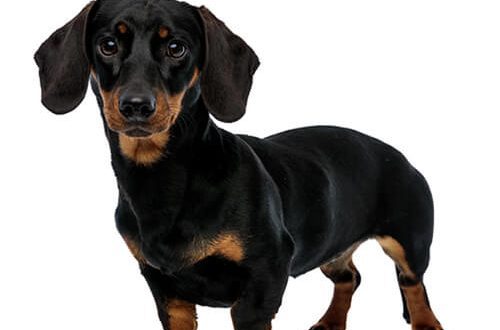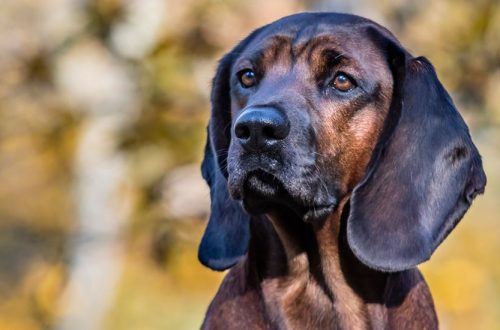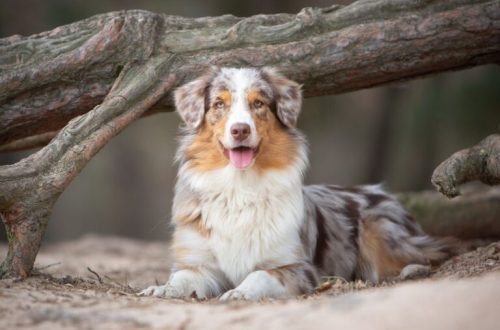
Karelian-Finnish Laika
Other names of Karelian-Finnish Laika: Finnish Spitz , Suomenpistikorva , Karelka
The Karelian-Finnish Laika is a hunting dog of a reddish-honey color, which in 2006 was combined into one breed with the Finnish Spitz. It showed itself well in hunting small fur-bearing animals, some species of birds and wild boar.
Contents
- Characteristics of Karelian-Finnish Laika
- Basic moments
- History of the Karelian-Finnish Laika breed
- Video: Karelo-Finnish Laika
- Appearance of the Karelian-Finnish Laika
- The nature of the Karelian-Finnish Laika
- Education and training
- Hunting with Karelian Laika
- Maintenance and care
- Health and diseases of Karelian-Finnish Laikas
- How to choose a puppy
- The price of the Karelian-Finnish Laika
Characteristics of Karelian-Finnish Laika
| Country of origin | Russia, Finland |
| The size | Average |
| Growth | up to 15 years |
| Weight | Males: 11–15 kg Females: 9–13 kg |
| Age | Males: 40-50 cm Bitches: 38-46 cm |
| FCI breed group | Spitz and breeds of primitive type |
Basic moments
- Karelian-Finnish Laikas were bred as universal hunters, equally deftly managing both squirrels and roe deer.
- An excess of cunning and independence among representatives of this breed somewhat interferes with their studies. Sometimes the animal can be stubborn and pretend, so these redheads will have to look for a special approach.
- Like most hunting dogs, Karelian-Finnish Laikas are very energetic animals that require regular physical exercise, so you will have to walk a lot and thoroughly with your pet.
- The average “Karelo-Finn” quickly takes root in the family, but may conflict with other members of the dog tribe if he sees them as rivals. The desire to lead and dominate – nothing can be done.
- The Karelian-Finnish Laika is a noisy dog that loves to voice even the smallest of things, so before you get a tiny red lump, ask yourself: are you ready to live in the company of such a talkative pet.
- Fearlessness and courage are the main hunting features of Karelian-Finnish Laikas. At the same time, they are prudent enough and do not attack too large animals.
- One of the most significant advantages of the breed is the compactness of its representatives, in comparison with other huskies. Such dogs do not require much space, they are convenient to transport, which is important for owners who regularly go hunting with their pets.
- In the circle of lovers of the Karelian-Finnish Laika breed, they are simply called Karelians.
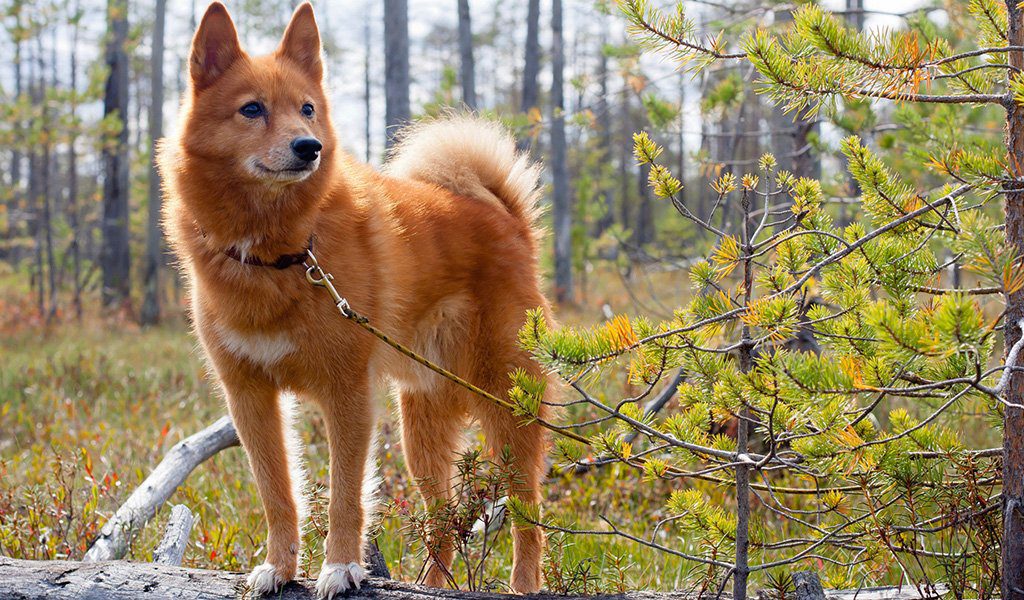
The Karelian-Finnish Laika is a noisy red-haired beauty, with the right training, capable of bombarding her own owner with hunting trophies. Possessing a mass of undeniable advantages, including such qualities important for a commercial breed as resourcefulness, courage, intuitive flair, these energetic hunters are a standard of self-sufficiency. That is why the possession of a karelka imposes a number of obligations on its owner: this is not the kind of dog that will love you in spite of everything, its respect and appreciation will have to be literally earned.
History of the Karelian-Finnish Laika breed
The Karelian-Finnish Laika is perhaps the most deprived of the domestic breeds, whose representatives never received their own standard and were absorbed by the more popular dog clan. Karelian Laikas appeared in Tsarist Russia at the end of the 19th century, and their main concentration was in the north and west of the country. Subsequently, the animals that lived in the border areas began to spontaneously interbreed with Finnish hunting dogs, which led to the birth of a separate breed branch. In fact, these were the first Karelian-Finnish Laikas, with whom the inhabitants of the northern provinces very successfully went to the capercaillie.
In 1936, the Karelians got to the All-Union Agricultural Exhibition, where they pleasantly surprised dog handlers. And in 1939 they even tried to standardize them, but at first the low number of livestock prevented the case, and then the Great Patriotic War. In the late 40s, Soviet breeders set out to turn Karelian-Finnish Laikas into universal hunters, starting to knit them with Finnish Spitz. As a result, the animals dramatically improved their exterior performance, which was the impetus for the large-scale import of Finnish Spitz into the USSR and the subsequent uncontrolled pumping of the breed. It got to the point that by the 80s, most individuals from domestic nurseries carried 70% of the blood of the Finnish Spitz.
In 1984, the question of standardizing the Karelian-Finnish Laikas again arose. This time, members of the Leningrad Society of Hunters and Fishermen undertook to solve the problem, who did not bother too much and ranked the animals as a family of Finnish Spitz. However, the final “disbandment” of the breed took place only in 2006, after the chairman of the Finnish Kennel Club and the president of the RKF signed an official agreement, according to which the Finnish Spitz and Karelian-Finnish Laika were declared a single breeding branch and received a common appearance standard. This created the illusion of some sort of orderliness, but did not stop the disputes about the differences between both dog clans. In particular, modern experts involved in testing the hunting talents of “Finns” and “Karels” assure that the performance of dogs is not the same,
Video: Karelo-Finnish Laika
Appearance of the Karelian-Finnish Laika
The Karelian-Finnish Laika is a medium-sized hunting breed with a fluffy “honey” coat and brown or black eyes. The dog has a dry strong type of constitution, almost a square format. “Boys” are on average slightly larger and more massive than “girls”. The breed standard defines the following parameters: height at the withers – 42-50 cm (for males) and 38-46 cm (for females); body weight – 12-13 kg and 7-10 kg, respectively.
Karelian-Finnish Laika Head
The skull of the Karelian looks oval on top and slightly convex on the sides. The eyebrows and occiput are not very pronounced, as is the frontal groove. The stop of representatives of this breed is clearly drawn, but not too sharp. The muzzle is narrow, with a flat back, dry.
Jaws and teeth
The jaws of the dog are massive, closed in a tight scissor bite. Teeth strong, even, symmetrically set.
Nose
The lobe is miniature, coal-colored.
Eyes
Karelian-Finnish Laikas have not very large, almond-shaped eyes set somewhat obliquely. The iris of the eye is colored dark.
Ears
Ears set high, erect. The ear cloth is small, pointed in shape, the outer side is hidden under a layer of thick short hair.
Karelian-Finnish Laika Neck
The neck of the Karelian-Finnish Laika is of normal length, but because of the voluminous woolen “collar” it gives the impression of being short and thick.
Frame
The correct “Karelo-Finn” is distinguished by a strong physique. The body of the dog is square in format with a straight back, a massive, sloping croup and well-defined withers. The abdomen is slightly tucked up.
limbs
The legs of the Karelian-Finnish Laika are straight, set parallel to each other. The forelegs are characterized by a developed skeleton, mobile, slightly inclined shoulder blades and a normal pastern. The hind legs of this breed are strong, with fleshy thighs, muscular lower legs and low set hocks. The paws of the dog are rounded, almost cat-like, while the front paws are slightly shorter than the hind ones.
Karelian-Finnish Laika Tail
The length of the tail of the Karelian-Finnish Laika is up to the hock. The part of the tail bordering the base is turned sharply towards the back, because of which the rest of it rushes down and hangs down to the thigh.
Wool
On the head and frontal part of all four limbs, the hair is comparatively short. On the body, tail and hips, the coat is longer, lush, noticeably lagging behind the body. The outer hair on the shoulder blades of males stands out especially – it is hard and stands almost upright.
Color
The backs of the Karelian-Finnish Laikas are more intensely colored and come in rich red or reddish-gold tones. The cheekbones, the inside of the ears, legs and tail, as well as the chest and underbelly of the dog are noticeably lighter. The presence of white patches on the paws and a light blaze on the chest is considered normal.
Disadvantages and vices of the breed
The most typical defects of the Karelian-Finnish Laikas are a large head, a heavy muzzle, an underdeveloped lower jaw, an excessively or insufficiently twisted tail. Quite often among the Karels one can find such deviations from the standard as sharp transitions between shades of color, hung to the sides, ears tilted back or directed towards each other with tips, as well as soft pasterns. If we talk about the disqualifying defects of the breed, then they include:
- blue and yellow colors of the iris;
- too soft tips of the ears;
- any deviation from the standard bite;
- wool with a wave or a pronounced curl;
- large white marks on the chest and the same “socks” on the legs of the animal;
- depigmented lobe;
- unreasonable aggression directed at a person.
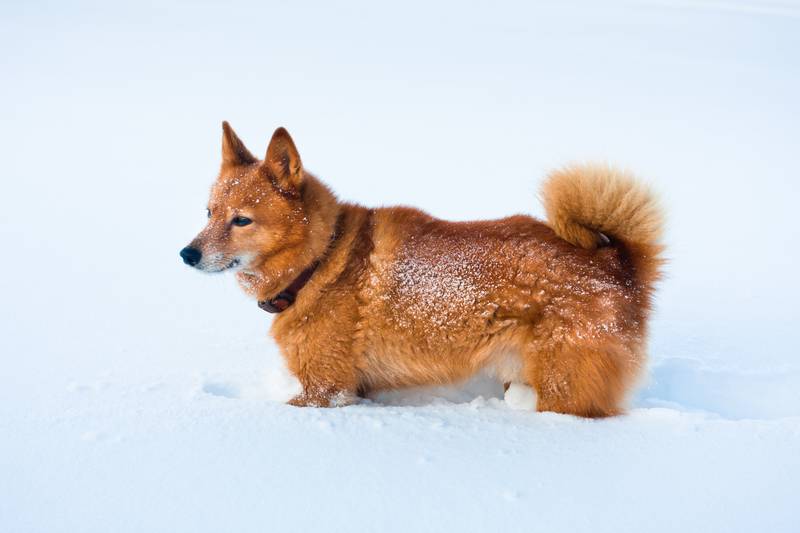

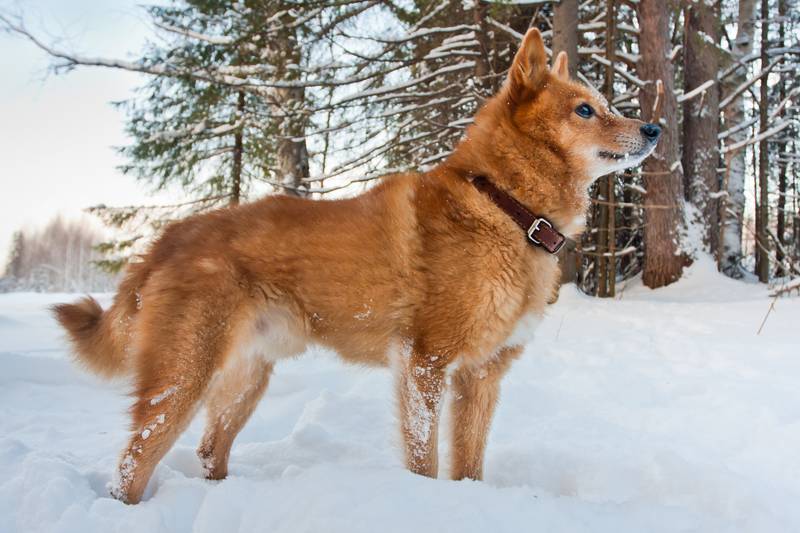

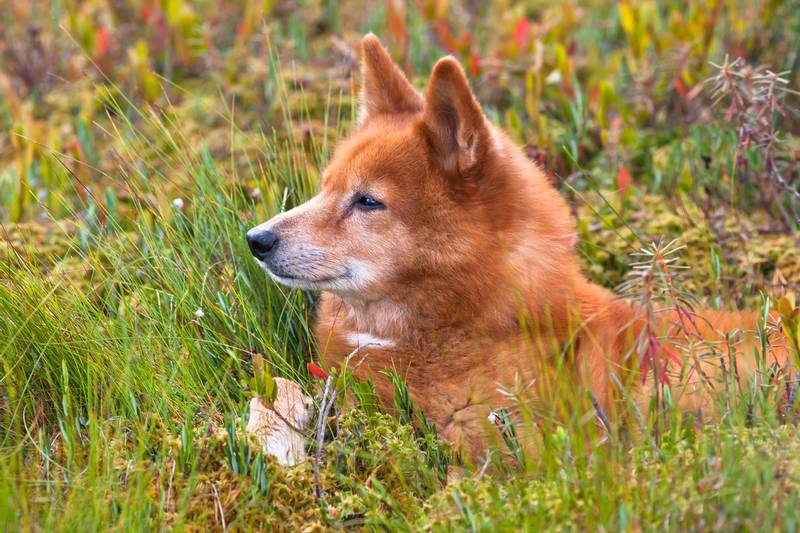

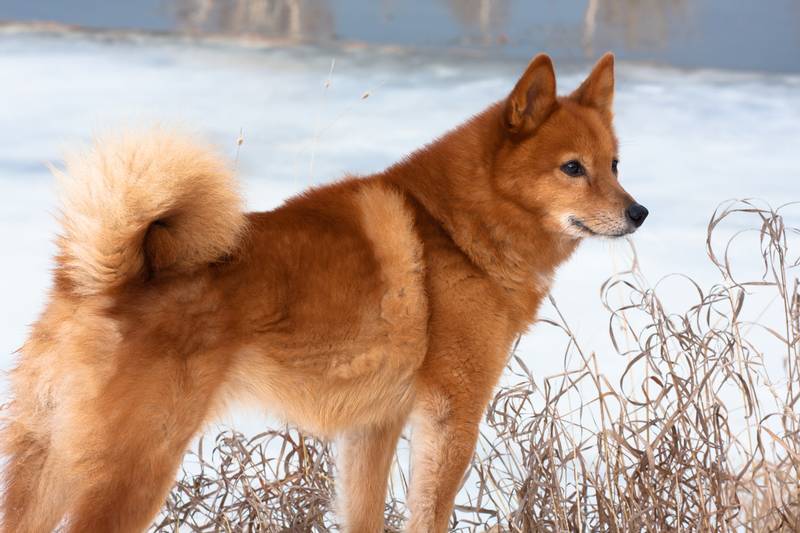

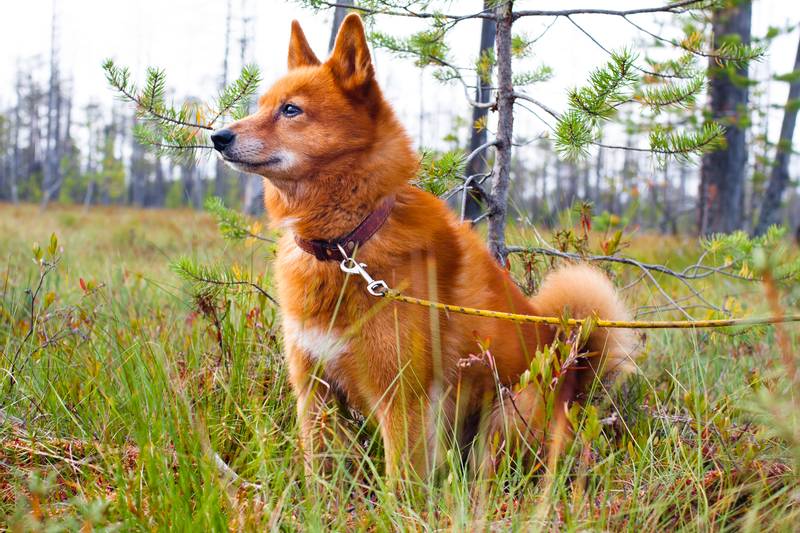

The nature of the Karelian-Finnish Laika
The Karelian-Finnish Laika is a cheerful, positive creature, but at the same time with a great sense of dignity, which should not be offended even by a beloved and adored owner. In general, “Karelo-Finns” are self-sufficient pets, responding with an even, benevolent attitude to good treatment and distrust and nervousness to a rude, authoritarian style of leadership. By the way, it is easiest to understand that a four-legged friend is offended by the tail, which straightens in irritated animals.
In childhood and adolescence, the Karelian-Finnish Laika gives the impression of being extremely dependent on the owner of the creature. She is obedient, executive, catches every glance of her mentor. But the older a dog gets, the faster its sense of self-worth grows. So stubbornness and independence are traits that you will almost certainly find in a four year old Karelian and almost never in puppies. However, if it seemed to you that Karelian-Finnish huskies are fixated only on themselves, then it really seemed to you. The Finnish Karelian Spitz is a good telepath and perfectly feels the mood of his own owner. He is far from slow-witted, so he quickly realizes what actions are expected of him, and in accordance with this he builds his own line of behavior.
Karelian-Finnish Laikas frankly dislike strangers who suddenly invade private territory, so raising a house watchman from a representative of this breed is as easy as shelling pears. As for the kids, the dogs have friendly relations with her, although not always ideal. That is, the karelka, of course, is not averse to playing catch-up with the kids, but in response to violence or outright infringement of their own rights, they can make a warning “Woof!”. In general, Karelian-Finnish Laikas are very convenient companions not only for professional hunters, but also for those who follow an active lifestyle. They will never refuse to run around the city parks with their owner and will gladly go to any picnic, you just have to whistle.
Education and training
The main difficulty in training Karelian-Finnish Laikas is the dog’s rapid loss of interest in classes. Yes, the Finnish Spitz is ready to learn, but not for long and for a treat. In addition, in order to work out the command to automatism, a representative of this breed will need at least 25-30 repetitions, which is not so little.
Karelian training begins in the standard way – with the pet recognizing its own nickname and the habit of settling down in the place allotted to it in the apartment. You need to work out the basic commands with the puppy very carefully and in doses so as not to overwork the baby. At three months, the Karelian-Finnish Laika should begin to get acquainted with such commands as “Sit!”, “Come!”, “No!”. From the same age, if you have a spring dog, you can teach her swimming lessons. Start by simply walking in warm puddles, gradually moving on to swimming in streams and other shallow waters. When the Karelian-Finnish Laika starts hunting, this skill will come in handy. Just do not forget to wash the animal with clean water after each such swim in order to clean the coat from bacteria and microorganisms living in open water.
At a young age, Karelian-Finnish Laikas are extremely destructive creatures, so you have to come to terms with the inevitability of material damage. It is important to understand that the puppy is not naughty out of harm, he just develops in this way and gets acquainted with the surrounding reality. If you plan to visit the countryside with your Finnish Spitz, train your dog to respond appropriately to poultry, for which the good old “No!” command will do. If it was not possible to control the pet, and he has already strangled a chicken or a goose, punish the four-legged bully without leaving the crime scene. Let things go on the brakes one and only time, and the Karelian-Finnish Laika will entertain itself for life hunting for bird herds.
Hunting with Karelian Laika
Despite the versatility of the breed in terms of hunting, with Karelian-Finnish huskies it is more expedient to go to small fur-bearing animals (squirrels, martens) and capercaillie. Carrels are excellent at finding and stopping game, skillfully scaring the animal under a shot, and finally fetching the shot prey. Theoretically, it is possible to bait a puppy from the age of four months, but not all huskies at this age have sufficient intelligence. So if at the first lesson the dog does not show interest in the animal, it is worth waiting another month or two. By the way, the training of the Finnish Spitz on a bear, which has become unexpectedly popular lately, is more of a show than a real hunt. It’s one thing to bark at a decoy clubfoot at a baiting station, and quite another to provoke a wild potapych at his native lair. Undoubtedly,
Sometimes the hunter’s instinct can doze off in a Finnish Spitz for up to a year and a half. You should not be afraid of this, since the Karelian-Finnish Laikas are excellent at catching up. The main thing is to keep your pet interested in work. For example, you can periodically give animal skins or a beaten bird for personal use to a puppy. If you have a second dog that has already taken part in the hunt, take her for training as well. Looking at the behavior of an older comrade, the puppy will definitely try to copy it.
In working with a large animal, representatives of this breed are especially careful, they do not lose their minds and never forget about the rules of their own safety. From an angry boar, the Karelian-Finnish Laika keeps at a respectful distance, while not ceasing to bark at him. By the way, such a cautious approach does not affect the prey in any way: without a trophy, red-haired Karelians almost never leave the forest.
Maintenance and care
The Karelian-Finnish Laika is not an open-air dog, much less a chain dog. Her place is in the house, in the company of a kind, understanding owner and members of his family. In addition, despite the fact that among hunters this type of husky enjoys a reputation for being “cold-resistant”, Russian frosts are not for her. As a compromise, the pet can be periodically moved to a booth in the yard, but only in the warm season. And by the way, do not really count on the fact that the furry hunter will be very pleased with such a move.
Equipping a separate sleeping place for a puppy in the house is a must, as well as accustoming him to it. Otherwise, in your absence, the Finnish Spitz will rest on your own bed. So in the first weeks of the dog’s stay in your home, do not be too lazy to cover an expensive sofa with newspapers – huskies usually do not encroach on a rustling bed.
From a month and a half, Karelian-Finnish Laikas begin to walk. The first walks can last 15-20 minutes, but as the dog grows older, they should be increased. It is optimal if the animal is taken outside twice a day for 2-3 hours. This is especially important for Karelians living in a large city, who need to compensate for the absence of the opportunity to hunt by walking. By the way, because of the developed stalking instincts, huskies are taken out of the house on a leash, otherwise there is a risk of losing the perky saffron milk cap forever.
Hygiene
You won’t have to be on duty near the Karelian-Finnish Laika with a furminator and lotion to facilitate combing, since the coat of representatives of this breed is problem-free, almost does not smell like a dog and sheds twice a year. The karelian is combed with a metal comb a couple of times a week and daily during the molting period. You can bathe an adult dog no more than 2-3 times a year. Remember that the husky, who regularly goes hunting, already takes unscheduled baths, jumping into the swamps for the shot game.
The eyes of the Karelian-Finnish Laika are relatively healthy, not prone to the formation of nitrous, so they do not require special care. The only thing – do not forget in the morning to remove lumps from the eye corners, the formation of which provokes dust that has fallen on the mucous. To do this, soak a clean cloth in chamomile infusion and gently wipe your eyes. If you notice purulent discharge, redness or increased tearfulness in your pet, visit a specialist – herbal decoctions alone cannot eliminate such problems.
Once a week, it is necessary to set aside time for a thorough examination of the dog’s ears, and once a month, the Karelian-Finnish Laika should have its nails trimmed. Brushing teeth for karels is also required, so every 3-4 days arm yourself with a toothpaste and brush head and treat the ward’s mouth. It is more correct to remove plaque in the veterinary office, but preventive measures to combat it can be taken at home. In particular, treat your Finnish Spitz regularly with pressed treats from the pet store and fresh tomatoes.
Like all hunting dogs that regularly travel to the forest, the Karelian-Finnish Laika needs increased protection against ticks, so do not skimp on funds from ectoparasites. In addition, from May to September (the peak of tick activity), inspect your pet’s coat after a walk. If you notice that a “free passenger” has clung to the carriage, pull it out with a twisting movement of tweezers and wipe the bite area with chlorhexidine. Now it remains only to observe the behavior of the animal. If the Karelian-Finnish Laika is playful and eats normally, you can breathe a sigh of relief – you have come across a harmless parasite. If the dog refuses to eat, looks lethargic, has a fever, and the urine has acquired a brownish tint, immediately take it to the veterinarian.
Feeding
Finnish Spitz against the background of other, larger huskies look like real little ones. At the same time, the energy from these red-haired creatures gushes like a fountain. Breeders usually already feed three-week-old puppies, so by 2-3 months, Karelian babies completely switch to an adult table. Approximately 20% of a teenage dog’s diet is lean meat. It is better if it is not a frozen product, but a steam room. The first option is also possible, but only after a thorough thawing.
Meat is always given to puppies of the Karelian-Finnish Laika cut into pieces and never in the form of minced meat, flying through the digestive tract at an accelerated pace and not bringing saturation. Bone cartilage is also a useful product and source of natural collagen, so you can like them already at 7 weeks of age. But with the bones it is better to wait until the puppy is at least 3 months old.
It is better to start introducing the animal to cereal products with milk semolina porridge, after a month or two replacing it with oatmeal. Millet, rice, buckwheat also have a place on the menu of the Finnish Spitz, but they will have to be cooked in meat broth, since not a single dog will voluntarily push cereal boiled on water into itself. Low-fat sour milk, vegetables (especially carrots), boneless sea fish are very useful for Karelian-Finnish huskies. An excellent treat for a pet will be dried fruits (not candied fruits) and cheese, but they should be given in portions and not enough.
Food in the dog’s bowl should be superimposed without a margin. If the Karelian-Finnish Laika has not finished the proposed dish, 15 minutes after the start of feeding, the bowl is removed, and the portion is reduced next time. This approach disciplines the animal, teaching it not to leave food for the next call. At 8 months, the puppy begins to eat according to the “adult” schedule, that is, twice a day. 1.5-month-old Karelians are fed frequently – up to 6 times a day, with each subsequent month reducing the number of meals by one.
Important: Karelian-Finnish Laikas, eating natural products, need vitamin and mineral supplements, since it is extremely difficult to balance the diet of a hunting dog on its own.
Health and diseases of Karelian-Finnish Laikas
Karelian-Finnish Laikas have a predisposition to joint dysplasia, dislocation of the limbs, and a little less often to epilepsy. Otherwise, they are quite healthy dogs with strong immunity.
How to choose a puppy
- First, look at the puppy’s parents and find out their age. It is better not to take Karelian-Finnish Laikas from a too young pair (female and male less than 1.5 years old).
- Do not place too high hopes on the working and champion diplomas of the baby’s mom and dad. Winners are not born, they are made.
- 6-week-old puppies of the Karelian-Finnish Laika should already have ears standing up. However, there is a small percentage of animals in which the ear lining rises only by 3 months. In this case, it is better to wait an extra couple of weeks to determine exactly who is in front of you – a worthy representative of the Karelian family or a tiny impostor.
- Pay attention to the number of puppies in the litter. Better if there are less than 6.
- The quality of the baby’s coat is also important, but it should be remembered that the Karelian-Finnish Laikas born in winter have the most spectacular “fur coats”.
- Carefully study the pedigree of a potential pet. If the same nicknames with the same numbers are repeated in it, this indicates that the breeder is fond of inbreeding (closely related crossing), and this is fraught with serious developmental deviations and external defects for litters.
- Evaluate the gait of a Karelian-Finnish Laika puppy. A healthy animal should have straight limbs without signs of rickets and move freely. If the puppy “thinks” before lying down or sitting down, not everything is fine with its musculoskeletal system.
- Groomed puppies with signs of a hernia, dirty ears and festering eyes undoubtedly cause pity, but to take such an animal means to get a lot of problems in the kit and forever give up the dream of walking around the ring with a pet.
The price of the Karelian-Finnish Laika
The cost of Karelian-Finnish Laika puppies with a pure pedigree and RKF metric starts from 450$ and ends around 1300 – 1500$. In the first case, these will be ordinary working dogs with possible defects in appearance, but developed hunting instincts. In the second – animals with a reference exterior and championship prospects, with which it is not a shame to go to foreign exhibitions.





